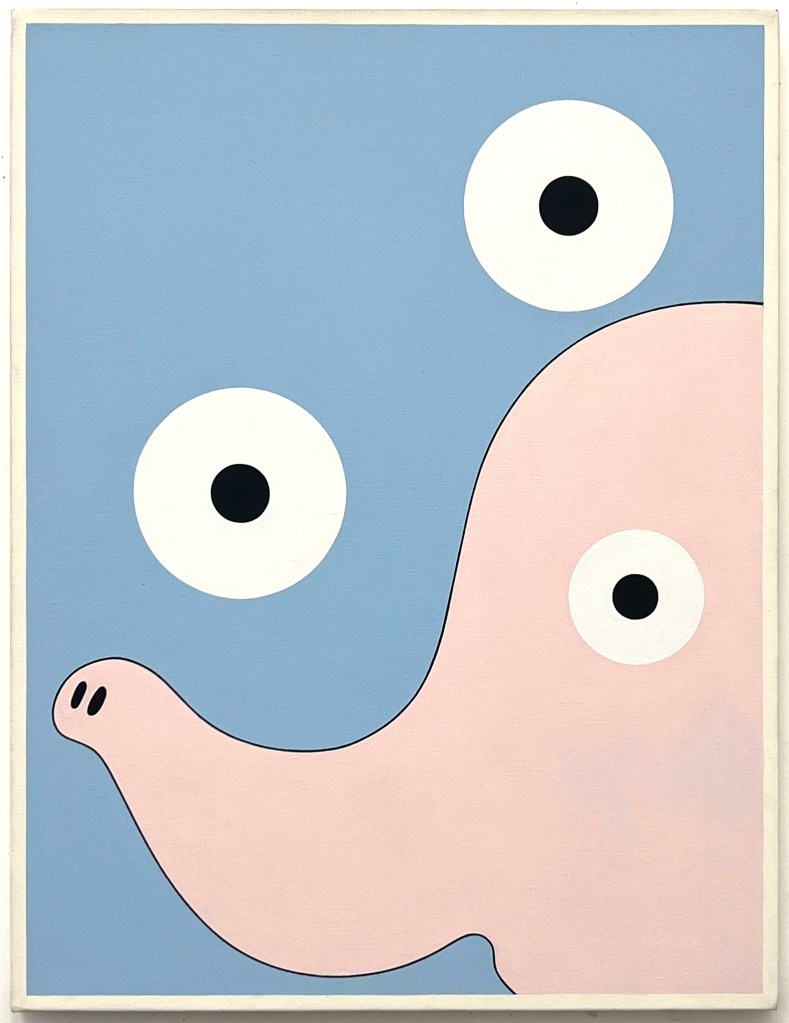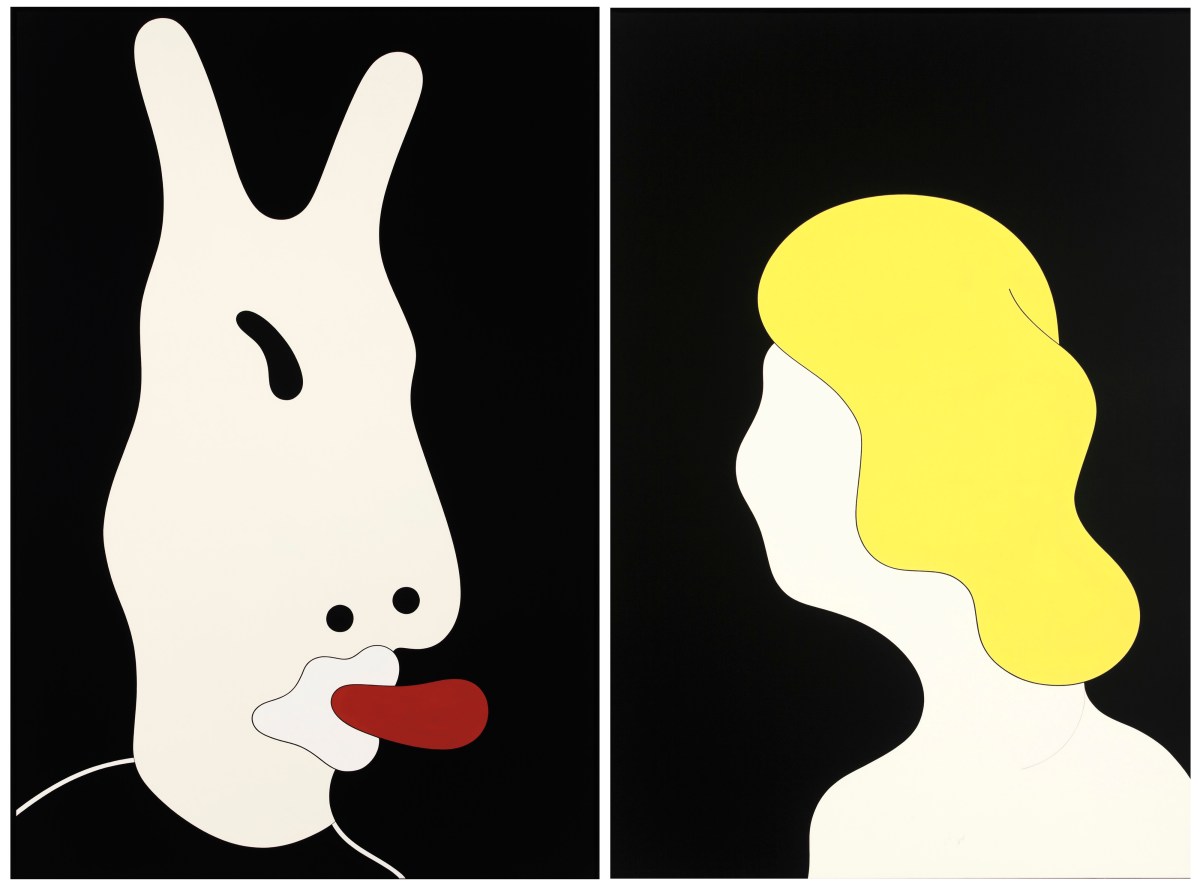This wide-ranging exhibition at TarraWarra Museum of Art showcases abstract surrealist painter and printmaker Brent Harris’ works from the past 40 years, primarily presented in chronological order from his early works in the late 1980s to some of his most recent work from 2023.
The exhibition title references sociologist Kurt H Wolff’s concept of ‘surrender and catch’. Harris often reflects on the process of psychoanalysis, both in his own life and in his artistic practice, and some of his artworks are entitled Surrender & Catch in recognition of this process. He also explores his, at times awkward, relationship with his body and desire, his relationship with his parents, as well as death and what follows, along with Biblical themes and iconography.
Harris has been a powerful voice in contemporary and abstract art since the 1980s, having studied at the Victorian College of the Arts from 1982 to 1984. Although born in Aotearoa New Zealand, much of his life has been spent in Australia, with some defining residencies in Paris and Rome. Inspired and influenced by other artists, including Peter Booth, New Zealand painter Colin McCahon, the Renaissance artists and psychologists, including Wolff, Harris’ work evolves and changes as he embraces different styles, techniques, materials, psychological processes and themes.
Echoes of Booth and McCahon can be seen in some of his early works in the exhibition, including Weeping Woman, with its heavy blacks and geometrical shapes, and The Stations, inspired by McCahon’s series of the same name.
When Harris strips out the colour, leaving only shapes and simple black and white articulations, with the occasional block colour, his artwork becomes arresting and powerful. Most striking in his earlier years is his first evocation of The Stations, where he draws on the canonical 14 Stations of the Cross that represent the different stages of Jesus’ death, from ‘Christ before Pilate’ to ‘The Entombment’. For Harris, this first exploration of The Stations was a way of processing the deaths of friends to AIDS in the 1980s.
The exhibition at TarraWarra includes three of these large pieces, as well as all 14 of the smaller accompanying prints he created at the same time. The bright white and heavy black forms partner and clash to create a stark sense of absence and emptiness.

Many of Harris’s artworks are playful, strange and grotesque, while at the same time, accessible in their humour. Works like his Appalling Moment series, with its repeating circles that look like eyes or portals, phallic elephant trunks and strange abstract fleshy bodies, were developed during a residency in Paris in the early 1990s, partially in reaction against the Parisian style he saw around him in the city.
The next phase of Harris’ work, from 1999 to 2001, is a series of carefully planned, drip paintings entitled Swamp. There’s a gentle grotesqueness to these artworks, taking Harris back to the two-toned style of earlier works, but with an organic structure and movement not found in the hard-edged abstract works in The Stations.
Harris has said these works emerged from his experiences as a teenager, feeling alone, isolated and struggling. The Swamp series of artworks are emotional and evocative in their simplicity.
A second residency, this time in Rome in 2009, stimulated another direction in Harris’ work – his Surrender & Catch artworks – and in these small densely coloured paintings there’s an echo of Renaissance art. The themes and symbols of Harris’ earlier works – open and staring eyes, the strange rabbit-like humans, dripping bodies and misproportioned hands – are also present, but in a swarm of colour applied directly to board or canvas.
These are accompanied by a small selection of delicate charcoal life drawings, again evoking the swampy bodies of earlier works, but on a smaller scale and with more gentleness and even affection.
In recent years, Harris has turned his attention to his home country of Aotearoa New Zealand, painting striking landscapes and a series of grotesquerie works that feature a mute blonde woman, likely a stand-in for his mother, and a dominant horned creature, a stand-in for his father. During the pandemic years, Harris revisited The Stations, bringing a more literal interpretation to the same concept. These artworks are all presented in full at TarraWarra, and their size, emotional clarity and simplicity are breathtaking.
This exhibition is an outstanding journey through the work of one of Australia’s most prominent surrealist artists. The sheer variety and diversity of Harris’ styles, influences, materials, processes and themes is invigorating. There’s a generosity in these artworks; Harris invites us in to see the world through his eyes, to feel what he feels, to understand things that may not be part of our lives. The understanding comes from feeling and being with the artworks, letting them work on us as they’re meant to.
Read: Exhibition review: John Nixon – Four Decades, Five Hundred Prints, Geelong Gallery
Exhibition Curator Maria Zagala sums up the value and importance of this exhibition: ‘Developed slowly over the course of many years, this exhibition presents a comprehensive overview of Harris’ formidable career. If the making of art can be seen as a process of excavation, then the circumstances of Brent Harris’ maturation – from a difficult childhood in Aotearoa New Zealand through to his early 20s as a gay man during the onset of the AIDS pandemic in Melbourne – provide the foundation from which his work has emerged over the past four decades.’
The exhibition showcases the Art Gallery of South Australia’s collection of Harris’ work and is augmented by works from the TarraWarra Museum of Art collection and loans from public and private collections.
Brent Harris: Surrender & Catch
TarraWarra Museum of Art
until 11 March 2024
Curator: Maria Zagala.
The exhibition will travel to the Art Gallery of South Australia, Adelaide, from 6 July – 20 October.





